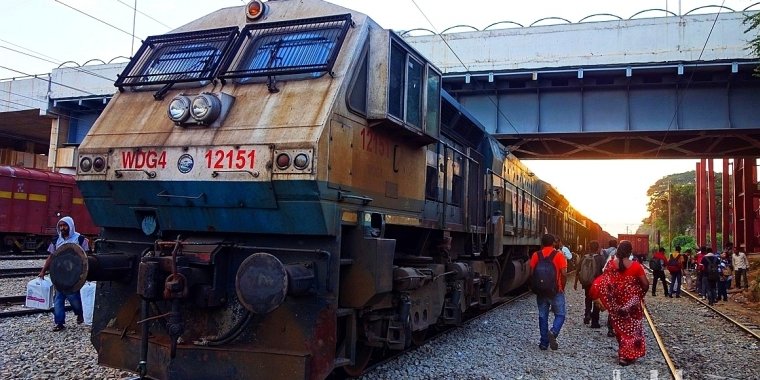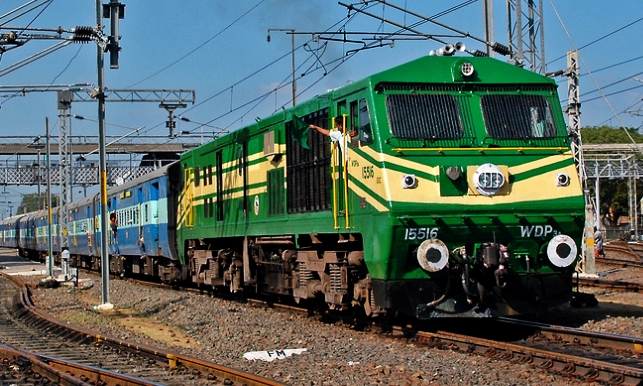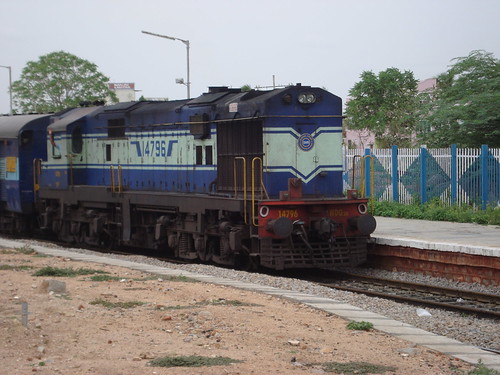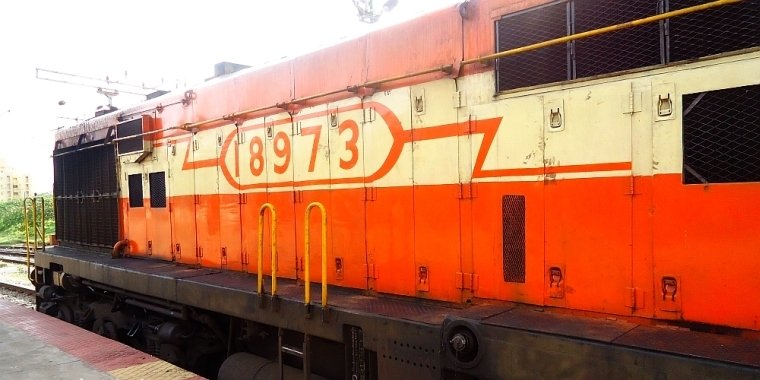Diesel Locomotive Roster – The WDP and WDG Series!

It took four decades after running around with the “mixed” WDM series that the Indian Railways finally thought that it would be a good idea to come out with separate dedicated specialized diesel locomotives (engines) for passenger and freight services. This resulted in a new set of two different types of locomotive, one each for passenger (WDP) and goods (WDG). It is interesting that this split for diesels happened only in 1995 through there were dedicated passenger locomotives for electric traction since 1963 (WAG1) and since 1980 (WAP1) for passenger. As Explained in a previous post, it is the difference in weight and Gear Ratios that separate locomotives into passenger and freight hauling types. The engine usually remains the same. Here is the history, details and specifications of dedicated passenger (WDP1, WDP3A, WDP4, WDP4B, WDP4D) and freight (WDG3A, 3B, 3C, 3D, WDG4, WDG4D, WDG5) service Diesel Locomotives.
[divider]
WDP1
 Low Powered version of the ALCO WDM2
Low Powered version of the ALCO WDM2- V12 4-Stroke Turbo Diesel ALCO 251V12
- Rated Power Output: 2300 hp
- Production Period: 1995 to 1999
- Number Produced: 69
- Wheel Arrangement: Bo-Bo
- Top (Rated) Speed: 140 kph
- Weight: 80.1t; AL: 20t; TE: 20t
The WDP1s were IR’s first attempt at a dedicated passenger diesel locomotive. The aim was to create a low-power locomotive to haul short-raked passenger services at better speeds, an experiment inspired by the WDM7. As the ALCOs were highly malleable, IR engineers tinkered around to rebuild the V16 of the WDM2 to produce a lower powered V12 which would power the WDP1. The locomotive was very light at 20t axle load and had a Bo-Bo wheel arrangement to make it more suited for speed and light loads. But the entire experiment fell flat as the locos performed poorly with lots of ride and maintenance problems, never getting to haul any substantial Express services. They are still in service and are homed either at TKD or BZA to haul short commuter trains around the area. They look just like all other ALCOs and are easily identified by the laterally “sculpted” and baldie grille-less short hood.
[divider]
WDP3A (WDP2)
- ALCO with a completely reworked shell

- V16 4-Stroke Turbo Diesel ALCO 251C
- Rated Power Output: 3100 hp
- Production Period: 1999 to 2002
- Number Produced: 69
- Wheel Arrangement: Co-Co
- Top (Rated) Speed: 160 kph
The WDP2 later renamed WDP3A was Indian Railways’ first success at creating a high-speed, high performance dedicated diesel passenger service locomotive with “modern” aerodynamic looks and dual cab forward design. Despite the swashbuckling exterior, inside the WDP3A still remains through and through ALCO with the same 3100 hp engine doing duty making it the almost identical brother of the WDM3A and WDG3A. They took the WDM3A, re-geared it, did away with the hood-unit driving structure and replaced it with two driving cabs at either end and extended the body shell all the way to the edge of the superstructure, giving it the “full” look, all the first of its diesel kind. But sadly production was stopped after it was decided to procure newer, more powerful and contemporary locomotives from EMD. A problem with the WDP3A was that it would get uncomfortably hot inside the driving cabin on the radiator side and the locos were nicknamed “toasters” by the loco pilots. The WDP3A is best known as the power for the Trivandrum Rajdhani on the Konkan Railway and are homed at Golden Rock Trichy (GOC) (SR) and Tughlakhabad (TKD) NR sheds. TKD WDM3As are named “Pushpak”. The WDP3A still remains one of IR’s most handsome locomotives.
[divider]
WDP4 (EMD GT46PAC)
 Brand new modern locos from EMD, USA.
Brand new modern locos from EMD, USA.- V16 2-Stroke Turbo Diesel GM-EMD 16-710
- Rated Power Output: 4000 hp
- Production Period: 2002 to 2011
- Number Produced: 102
- Wheel Arrangement: Bo1-1Bo
- Top (Rated) Speed: 160 kph
The WDP4 would change Indian passenger diesel services for ever. These 4000 hp single cab-forward behemoths that took India by storm were originally the GT46PAC exclusively built and supplied for the Indian Railways by EMD, USA in 2001. The first few units were fully imported and then some were assembled in India from CKD units before DLW started manufacturing them in India. #20012 “Baaz” was the first fully-Indian produced unit and most were homed at Hubli (UBL). These EMDs were light-years ahead of most ALCOs by being technologically well advanced with unit fuel injection, self-diagnostics, microprocessor control for optimum power delivery to traction motors etc. However, the WDP4 had two major flaws. The well-known one is their single-cabin design which seemingly caused visibility problems while being driven in LHF mode. Maybe to save cost, IR decided to go with only one cabin with a second control stand in it to drive it in LHF mode which it wasn’t really designed to. The second not-so-well-known problem with the WDP4 was that they had only 4 traction motors (2 per bogie) or only four out of the total six axles were powered, resulting in a weird Bo1-1Bo wheel arrangement. This was apparently aimed at reducing weight (and cost?) and for increased speed, but their resulting low tractive effort of 28t caused magnitudes of performance problems and unending wheel slips, though they were fantastically fast hauling shorter, lighter trains. Its shortcomings led to the development of the WDP4B (based on the WDG4). The WDP4s did good service though they are not being produced anymore.
[divider]
WDP4B
 Improved version of the WDG4 EMD
Improved version of the WDG4 EMD- V16 2-Stroke Turbo Diesel GM-EMD 16-710
- Rated Power Output: 4500 hp
- Production Period: 2010 to Present
- Number Produced: 85+
- Wheel Arrangement: Co-Co
- Top (Rated) Speed: 130 kph
Though classified WDP and designed to overcome the shortcomings of the WDP4, the WDP4B is actually a modified version of the WDG4 and not of the WDP4. It has 6 traction motors for all the six axles like the WDG4, has a tractive effort of 40t (385 kN) compared to the WDG4’s 55t (570kN) and the WDP4s 28t (270kN) and axle load of 20.2t slightly lesser than the WDG4’s 21t and same operational speed (130 kph) of the WDG4. The reworked EMD engine outputs 4500 hp. The WDP4B also has a much more rounded “softer” aerodynamic front-end with the cabin slightly wider than the loco body to provide bigger windows for better visibility, which also took away the fierce, menacing front-end look of the original EMD. All other specs remained the same as that of the WDG4 including all the technological goodies. However, they did not do anything about the cab design and the LHF end was unfortunately left untouched retaining its weird house-shaped look as the loco continued with one cab. The WDP4B hence was suited for hauling longer trains at somewhat higher speed than the WDP4.
[divider]
WDP4D
 Dual cab (longer) version of the WDP4B
Dual cab (longer) version of the WDP4B- V16 2-Stroke Turbo Diesel GM-EMD 16-710
- Rated Power Output: 4500 hp @ 900 RPM
- Production Period: 2010 to Present
- Top Rated Speed: 130 kph
- Number Produced: 245+
- Wheel Arrangement: Co-Co
- Top (Rated) Speed: 130 kph
- Axle Load: 20.5t, Tractive Effort: 39.5t
The WDP4B with its tweaked GM engine got a facelift with the WDP4D. After numerous complaints from loco pilots, engineers, media and the general public who refused to allow trains with WDP4s to operate in LHF mode, IR finally realized that it would be a good idea to add another cab to the EMD. The WDP4D was the result where D stands for “Dual Cab” and not for horsepower. These are long, very looooong locos which apart from the extra cab share all features with the WDP4B. The extra cab is a bit wider than the other one and looks slightly ungainly but is more efficient, easier to operate and better looking, besides being more safer, faster and comfortable for the poor loco pilots. It was only the second dual-cab diesel locomotive after the WDP3A. Some of the newer locos also have air-conditioning and toilets built in as standard features and also have one of the cabs lo0king a bit odd (flat). They all were initially housed at Tughlakabad, but are now also seen at Siliguri and Golden Rock sheds and as far south as Ernakulam. Very powerful with a starting TE of 39500 kg.
[divider]
WDG1
There is surprisingly no locomotive classified WDG1 on Indian Railways. However, there is evidence enough to believe that a WDG1 class could have actually existed once as an experimental or prototype class which never went into production. The existence of the WDG2 (later reclassified WDG3A) points to the existence of the WDG1 class, because locomotives those days were classified chronologically or version-wise.
[divider]
WDG3A (WDG2)
 Dedicated freight version of the WDM3A
Dedicated freight version of the WDM3A- V16 4-stroke Turbo Diesel ALCO 251C-16
- Rated Power Output: 3100 hp @ 1050 RPM
- Production Period: 1995 to Present
- Number Produced: 1171+
- Wheel Arrangement: Co-Co
- Top (Rated) Speed: 100 kph
- Axle Load: 20.5 t; Total Weight: 123 t.
- Starting Tractive Effort: 3
7.9 t at 30.8% adhesion
The WDG3A was also developed to overcome the shortcomings of the WDM2 and is the triplet brother of the WDM3A and WDP3A. All WDX3As share the same 3100 hp powerpack but are different on how they were specifically engineered for the work they are supposed to do. The WDG3A has higher Tractive Effort (37.9 t) and Axle Load (20.5 t) compared to the WDM3A which are 30.4 t and 18.8 t. Freight locomotives have to haul far heavier loads as compared to passenger services and hence require to be heavier and have higher effort to get moving. The WDG3A is one of IR’s most successful locomotives and most common locomotive today with 1171 produced and still going strong, the only ALCO currently in production along with the WDM3D. The older WDG3As look exactly like the WDM3A in all aspects while the newer ones look like the WDM3D and share all its characteristics and features including microprocessor control and short-hood mounted DBRs. Very rugged and very reliable though tad underpowered, WDG3As are still drive a huge chunk of India’s economy, moving coal, petroleum products, cement, grain, containers and what not across the nation. Many are famously known as “Shakti” and have lightning bolts pained on them. Found all over the country from Ludhiana to Ernakulam but more famously along the dusty plains of the Deccan and Andhra Pradesh, at Pune, Guntakal, Gooty, Kazipet and Vizag.
[divider]
WDG3B
 Experimental higher powered variant of WDG3A?
Experimental higher powered variant of WDG3A?- Class does not exist today, no confirmed sightings
- V16 4-stroke Turbo Diesel ALCO 251C
- Rated Power Output: 3200 hp?
- Production Period: 2004?
- Number Produced: 4?
- Wheel Arrangement: Co-Co
Nothing much is known about this (WDG3B) loco class. Apparently around four of these were built with all of them homed at Gooty. Maybe they were a technical variant of the WDG3A with an upgraded ALCO engine to output 3200 hp as the name suggests. But it looks like the experiment didn’t work out because there is no record of any locomotives of this class today and no confirmed sightings of any of WDG3Bs except for a 2004 account by a railfan reporting a Gooty WDG3B #14796 (pictured here). This loco is now a WDG3A with SWR KJM.
[divider]
WDG3C
 Supposedly Higher powered WDG3A?
Supposedly Higher powered WDG3A?- V16 4-stroke Turbo Diesel ALCO 251C
- Rated Power Output: 3300 hp
- Production Period: 2001?
- Number Produced: 1
- Wheel Arrangement: Co-Co
The WDG3C was another one of those experiments to crank out higher power from the ALCO but didn’t really succeed. Only one was produced (#14962) and was homed at Gooty. It had a brilliant and unique Dark Rose-Yellow livery with “Cheetah 3300” painted on its sides. It was the only confirmed WDG3C to be produced and remained so until 2011 when it was derated to 2600 hp (but marked WDG3A) and painted in standard Katni (Orange and twin Cream bands) colors, marking the demise of the class. The 14962 is still in service.
[divider]
WDG3D
- WDG3A variant with microprocessor control

- Supposedly a freight version of WDM3D?
- V16 4-stroke Turbo Diesel ALCO 251C
- Rated Power Output: 3400 hp
- Production Period: 2001
- Number Produced: 1
- Wheel Arrangement: Co-Co
Another upgraded variant of the WDG3A. The WDG3D also had only one unit produced #13301 which was first homed at Andal and later at Vatva. It supposedly had 3400 hp engine power, better cabin ergonomics and microprocessor control, seemingly a freight version of the WDM3D, sharing most of its features. Present status unknown. Photo courtesy IRFCA.
[divider]
WDG4
 Totally new and modern locos from EMD USA
Totally new and modern locos from EMD USA- V16 2-stroke Turbo Diesel GM 16-710G3B
- Rated Power Output: 4000 hp @ 900 RPM
- Engine Displacement: 186160 cc
- Production Period: 1999-2012
- Number Produced: 431
- Wheel Arrangement: Co-Co
The massive WDG4 changed everything! It was the first ever mainline production EMD in India after the (experimental) WDM4 four decades ago. Their looks, stance and power were intimidating (at least from one end) and were totally unlike anything India had seen until then. It predated the WDP4 by two years and was originally the GT46MAC designed and built by Electro-Motive Diesel (EMD) of USA. First few were imported and then DLW started building them in India and most were sent to Hubli (UBL). With 53 tonnes tractive effort, 21 tonnes axle load and 4000 hp power with self-driven bolsterless bogies and 3-phase traction motors (3 per bogie), the WDP4 was the most powerful diesel locomotive in India at the time and could pull a fully loaded 58-wagon BOXN load up a 2.5% gradient without breaking a sweat. Two WDG4s coupled together could haul more than what took three ALCOs previously. Though they don’t look so, the EMDs are extremely hi-tech equipment filled to the brim with electronic wizardry. Computers control almost everything right from valve control and fuel injection to voltage and power delivery. It also features ABS, traction control, self diagnostics, automatic sanding and it even has a radar and autopilot and later EMDs including the WDP4 share all of its features. The mileage of the WDP4 EMD diesel locomotive is 4 liters of diesel per kilometer, remarkably cost effective considering what they haul. The earlier WDG4s had the rough-cut look frontal look while the later ones share the blunter, wider cab of the WDP4B. The WDG4/WDP4 will cost you 12 Crore a piece and the WDG4 is also my favorite loco model. However, the single cab design was a pain point as it was for all EMDs. Read here a full review of the WDG4 EMD (PDF).
[divider]
WDG4D (Vijay)
 Completely developed and built in India.
Completely developed and built in India.- Based on EMD WDG4 but with a modified engine.
- V16 2-stroke Turbo Diesel GM 16-710G3B
- Rated Power Output: 4500 hp @ 900 RPM
- Top Speed: 105 kph
- Production Period: 2013+
- Number Produced: 215+
- Wheel Arrangement: Co-Co
Named “Vijay”, the WDP4D is the latest entrant to the Indian Railways’ locomotive fleet. It is India’s first ever dual-cab diesel freight locomotive and can be said to be the freight version of the WDP4D or a WDG4 with cabs at both ends thereby finally eliminating its biggest shortcoming. It is built around the same upgraded 4500 hp EMD 710 G3B engine doing duty in the WDP4B and WDP4D. Like all EMDs, the WDG4D is extremely high-tech being fully computer controlled and most functions being automated including optimum power delivery to the 3-phase traction motors using IGBT (transistors), the same technology used in 3-phase AC locomotives (WAP5/7, WAG9). The loco design also gives lot of attention to the comfort of loco pilots who until now were the most neglected souls when it comes to locomotive design. Both cabs are fully air conditioned with ergonomic and comfortable reclining seats and the driving console has been substantially digitized with TFT display screens showing all parameters of loco function, performance and fault diagnostics like an airplane, if you will. The first one to be built is #12681 and is homed at Sabarmati (SBI) shed of Western Railway in Gujarat.
[divider]
WDG5 (Bheem)
 Loosely based on the EMD SD80MAC (engine)
Loosely based on the EMD SD80MAC (engine)- Developed jointly by RDSO and EMD in India.
- V20 2-stroke Turbo Diesel GM 20-710G3B
- Rated Power Output: 5500 hp @ 900 RPM
- Top Speed: 105 kph
- Production Period: 2012
- Number Produced: 4
- Wheel Arrangement: Co-Co
The WDG5 “Bheem” is Indian Railways’ latest attempt at high powered diesel locomotives and is currently the most powerful diesel locomotive in India. This very, very long locomotive was was derived from the American locomotive EMD SD80MAC and was developed fully in India jointly by EMD and RDSO for Indian Railways. It was classified as the GT50AC by EMD. The WDG5 boasts of the very first 20-Cylinder (v20) locomotive engine, the V20-710G3B prime mover of the SD80MAC, which has been tweaked to output 5500 hp at its existing top speed of 900 RPM to do duty on the WDG5. The locomotive is crammed with high-tech features and also includes an air-conditioned cabin with a fully digital control stand and a toilet for the loco pilots. The cabin looks a bit awkward but is highly functional and of course, air-conditioned. However, everything is not so cool with this loco, despite its high-power and advanced features. The biggest problems was the design of the LHF end which is worse than that of the WDG/P4 and has come in for much criticism. The WDG5 is supposedly still under testing as it apparently has a lot of ride and performance problems and of course visibility problems. Only one (50001) was produced and was not assigned to any shed. Future prospects unknown. UPDATE: 3 more have been produced but they seem to have not entered serious service yet.
This concludes the story of Indian Railways’ Diesel locomotives. To know more about the working of locomotives, check here.
More Chapters on Indian Locomotives
Locomotives of the Indian Railways | Locomotives Terminologies and Design
How Locomotives are Classified | How Electric and Diesel Locomotives Work
DIESELS: The WDM Series (ALCOs) | The WDP and WDG Series (ALCOs and EMDs)
ELECTRICS: DC & AC/DC Locos | WAM (AC mixed) | WAG (AC Freight) | WAP (AC Passenger)



